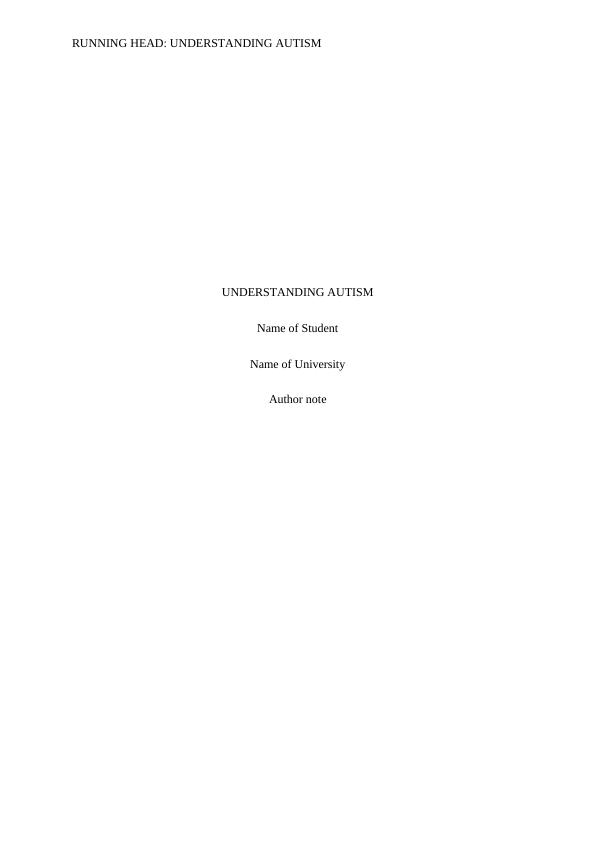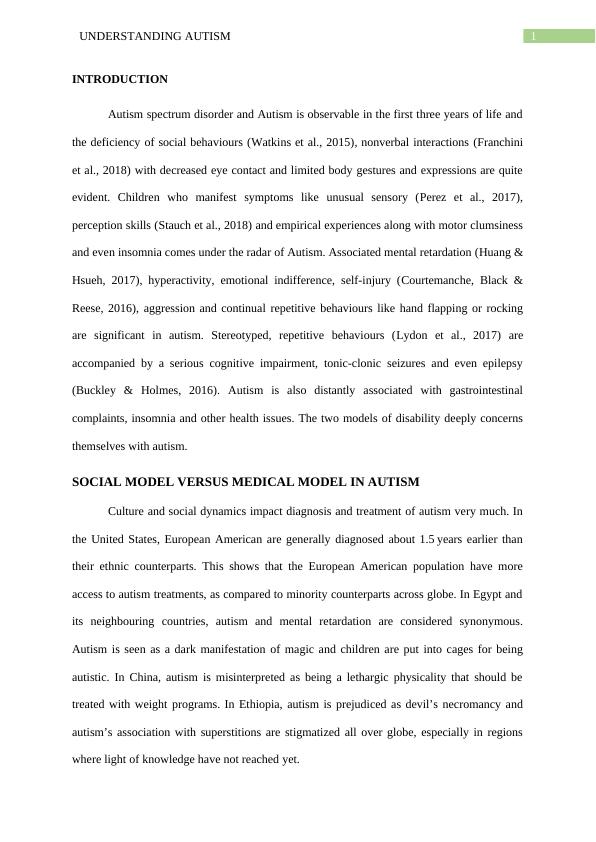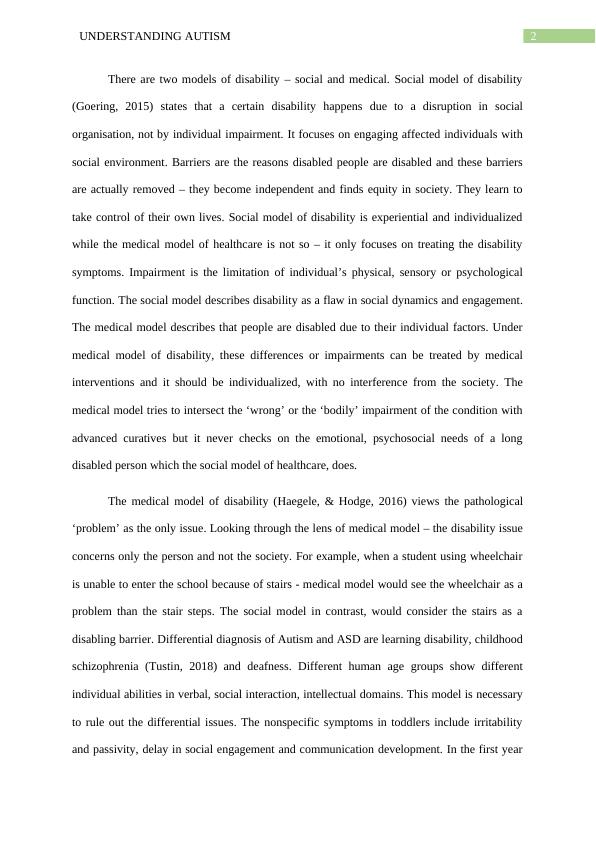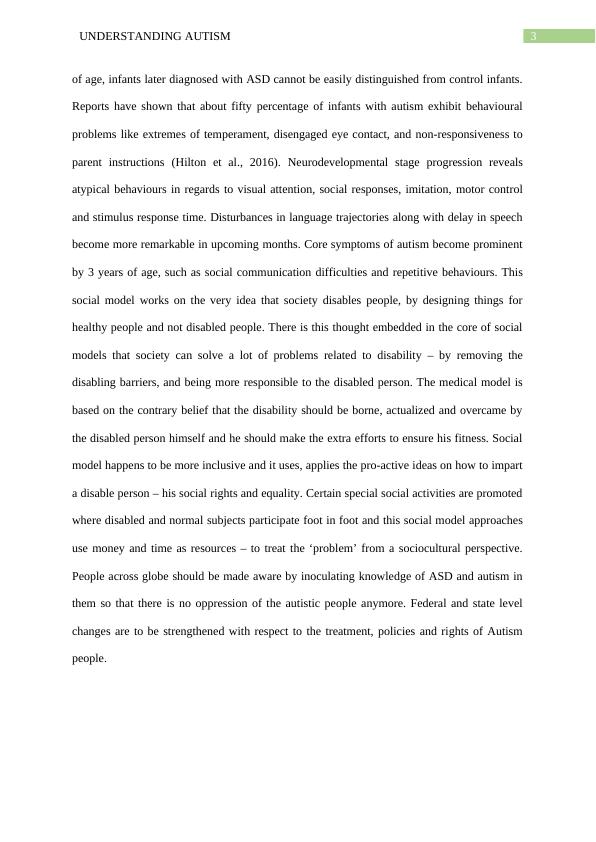Understanding Autism
11 Pages2620 Words407 Views
Added on 2023-03-31
About This Document
This article provides an in-depth understanding of Autism, including its characteristics, diagnosis, and treatment. It explores the impact of sociocultural perception on Autism and discusses the role of social and medical models of disability in managing the condition. The article emphasizes the importance of integrating social and medical interventions to improve the quality of life for individuals with Autism.
Understanding Autism
Added on 2023-03-31
ShareRelated Documents
RUNNING HEAD: UNDERSTANDING AUTISM
UNDERSTANDING AUTISM
Name of Student
Name of University
Author note
UNDERSTANDING AUTISM
Name of Student
Name of University
Author note

1UNDERSTANDING AUTISM
INTRODUCTION
Autism spectrum disorder and Autism is observable in the first three years of life and
the deficiency of social behaviours (Watkins et al., 2015), nonverbal interactions (Franchini
et al., 2018) with decreased eye contact and limited body gestures and expressions are quite
evident. Children who manifest symptoms like unusual sensory (Perez et al., 2017),
perception skills (Stauch et al., 2018) and empirical experiences along with motor clumsiness
and even insomnia comes under the radar of Autism. Associated mental retardation (Huang &
Hsueh, 2017), hyperactivity, emotional indifference, self-injury (Courtemanche, Black &
Reese, 2016), aggression and continual repetitive behaviours like hand flapping or rocking
are significant in autism. Stereotyped, repetitive behaviours (Lydon et al., 2017) are
accompanied by a serious cognitive impairment, tonic-clonic seizures and even epilepsy
(Buckley & Holmes, 2016). Autism is also distantly associated with gastrointestinal
complaints, insomnia and other health issues. The two models of disability deeply concerns
themselves with autism.
SOCIAL MODEL VERSUS MEDICAL MODEL IN AUTISM
Culture and social dynamics impact diagnosis and treatment of autism very much. In
the United States, European American are generally diagnosed about 1.5 years earlier than
their ethnic counterparts. This shows that the European American population have more
access to autism treatments, as compared to minority counterparts across globe. In Egypt and
its neighbouring countries, autism and mental retardation are considered synonymous.
Autism is seen as a dark manifestation of magic and children are put into cages for being
autistic. In China, autism is misinterpreted as being a lethargic physicality that should be
treated with weight programs. In Ethiopia, autism is prejudiced as devil’s necromancy and
autism’s association with superstitions are stigmatized all over globe, especially in regions
where light of knowledge have not reached yet.
INTRODUCTION
Autism spectrum disorder and Autism is observable in the first three years of life and
the deficiency of social behaviours (Watkins et al., 2015), nonverbal interactions (Franchini
et al., 2018) with decreased eye contact and limited body gestures and expressions are quite
evident. Children who manifest symptoms like unusual sensory (Perez et al., 2017),
perception skills (Stauch et al., 2018) and empirical experiences along with motor clumsiness
and even insomnia comes under the radar of Autism. Associated mental retardation (Huang &
Hsueh, 2017), hyperactivity, emotional indifference, self-injury (Courtemanche, Black &
Reese, 2016), aggression and continual repetitive behaviours like hand flapping or rocking
are significant in autism. Stereotyped, repetitive behaviours (Lydon et al., 2017) are
accompanied by a serious cognitive impairment, tonic-clonic seizures and even epilepsy
(Buckley & Holmes, 2016). Autism is also distantly associated with gastrointestinal
complaints, insomnia and other health issues. The two models of disability deeply concerns
themselves with autism.
SOCIAL MODEL VERSUS MEDICAL MODEL IN AUTISM
Culture and social dynamics impact diagnosis and treatment of autism very much. In
the United States, European American are generally diagnosed about 1.5 years earlier than
their ethnic counterparts. This shows that the European American population have more
access to autism treatments, as compared to minority counterparts across globe. In Egypt and
its neighbouring countries, autism and mental retardation are considered synonymous.
Autism is seen as a dark manifestation of magic and children are put into cages for being
autistic. In China, autism is misinterpreted as being a lethargic physicality that should be
treated with weight programs. In Ethiopia, autism is prejudiced as devil’s necromancy and
autism’s association with superstitions are stigmatized all over globe, especially in regions
where light of knowledge have not reached yet.

2UNDERSTANDING AUTISM
There are two models of disability – social and medical. Social model of disability
(Goering, 2015) states that a certain disability happens due to a disruption in social
organisation, not by individual impairment. It focuses on engaging affected individuals with
social environment. Barriers are the reasons disabled people are disabled and these barriers
are actually removed – they become independent and finds equity in society. They learn to
take control of their own lives. Social model of disability is experiential and individualized
while the medical model of healthcare is not so – it only focuses on treating the disability
symptoms. Impairment is the limitation of individual’s physical, sensory or psychological
function. The social model describes disability as a flaw in social dynamics and engagement.
The medical model describes that people are disabled due to their individual factors. Under
medical model of disability, these differences or impairments can be treated by medical
interventions and it should be individualized, with no interference from the society. The
medical model tries to intersect the ‘wrong’ or the ‘bodily’ impairment of the condition with
advanced curatives but it never checks on the emotional, psychosocial needs of a long
disabled person which the social model of healthcare, does.
The medical model of disability (Haegele, & Hodge, 2016) views the pathological
‘problem’ as the only issue. Looking through the lens of medical model – the disability issue
concerns only the person and not the society. For example, when a student using wheelchair
is unable to enter the school because of stairs - medical model would see the wheelchair as a
problem than the stair steps. The social model in contrast, would consider the stairs as a
disabling barrier. Differential diagnosis of Autism and ASD are learning disability, childhood
schizophrenia (Tustin, 2018) and deafness. Different human age groups show different
individual abilities in verbal, social interaction, intellectual domains. This model is necessary
to rule out the differential issues. The nonspecific symptoms in toddlers include irritability
and passivity, delay in social engagement and communication development. In the first year
There are two models of disability – social and medical. Social model of disability
(Goering, 2015) states that a certain disability happens due to a disruption in social
organisation, not by individual impairment. It focuses on engaging affected individuals with
social environment. Barriers are the reasons disabled people are disabled and these barriers
are actually removed – they become independent and finds equity in society. They learn to
take control of their own lives. Social model of disability is experiential and individualized
while the medical model of healthcare is not so – it only focuses on treating the disability
symptoms. Impairment is the limitation of individual’s physical, sensory or psychological
function. The social model describes disability as a flaw in social dynamics and engagement.
The medical model describes that people are disabled due to their individual factors. Under
medical model of disability, these differences or impairments can be treated by medical
interventions and it should be individualized, with no interference from the society. The
medical model tries to intersect the ‘wrong’ or the ‘bodily’ impairment of the condition with
advanced curatives but it never checks on the emotional, psychosocial needs of a long
disabled person which the social model of healthcare, does.
The medical model of disability (Haegele, & Hodge, 2016) views the pathological
‘problem’ as the only issue. Looking through the lens of medical model – the disability issue
concerns only the person and not the society. For example, when a student using wheelchair
is unable to enter the school because of stairs - medical model would see the wheelchair as a
problem than the stair steps. The social model in contrast, would consider the stairs as a
disabling barrier. Differential diagnosis of Autism and ASD are learning disability, childhood
schizophrenia (Tustin, 2018) and deafness. Different human age groups show different
individual abilities in verbal, social interaction, intellectual domains. This model is necessary
to rule out the differential issues. The nonspecific symptoms in toddlers include irritability
and passivity, delay in social engagement and communication development. In the first year

3UNDERSTANDING AUTISM
of age, infants later diagnosed with ASD cannot be easily distinguished from control infants.
Reports have shown that about fifty percentage of infants with autism exhibit behavioural
problems like extremes of temperament, disengaged eye contact, and non-responsiveness to
parent instructions (Hilton et al., 2016). Neurodevelopmental stage progression reveals
atypical behaviours in regards to visual attention, social responses, imitation, motor control
and stimulus response time. Disturbances in language trajectories along with delay in speech
become more remarkable in upcoming months. Core symptoms of autism become prominent
by 3 years of age, such as social communication difficulties and repetitive behaviours. This
social model works on the very idea that society disables people, by designing things for
healthy people and not disabled people. There is this thought embedded in the core of social
models that society can solve a lot of problems related to disability – by removing the
disabling barriers, and being more responsible to the disabled person. The medical model is
based on the contrary belief that the disability should be borne, actualized and overcame by
the disabled person himself and he should make the extra efforts to ensure his fitness. Social
model happens to be more inclusive and it uses, applies the pro-active ideas on how to impart
a disable person – his social rights and equality. Certain special social activities are promoted
where disabled and normal subjects participate foot in foot and this social model approaches
use money and time as resources – to treat the ‘problem’ from a sociocultural perspective.
People across globe should be made aware by inoculating knowledge of ASD and autism in
them so that there is no oppression of the autistic people anymore. Federal and state level
changes are to be strengthened with respect to the treatment, policies and rights of Autism
people.
of age, infants later diagnosed with ASD cannot be easily distinguished from control infants.
Reports have shown that about fifty percentage of infants with autism exhibit behavioural
problems like extremes of temperament, disengaged eye contact, and non-responsiveness to
parent instructions (Hilton et al., 2016). Neurodevelopmental stage progression reveals
atypical behaviours in regards to visual attention, social responses, imitation, motor control
and stimulus response time. Disturbances in language trajectories along with delay in speech
become more remarkable in upcoming months. Core symptoms of autism become prominent
by 3 years of age, such as social communication difficulties and repetitive behaviours. This
social model works on the very idea that society disables people, by designing things for
healthy people and not disabled people. There is this thought embedded in the core of social
models that society can solve a lot of problems related to disability – by removing the
disabling barriers, and being more responsible to the disabled person. The medical model is
based on the contrary belief that the disability should be borne, actualized and overcame by
the disabled person himself and he should make the extra efforts to ensure his fitness. Social
model happens to be more inclusive and it uses, applies the pro-active ideas on how to impart
a disable person – his social rights and equality. Certain special social activities are promoted
where disabled and normal subjects participate foot in foot and this social model approaches
use money and time as resources – to treat the ‘problem’ from a sociocultural perspective.
People across globe should be made aware by inoculating knowledge of ASD and autism in
them so that there is no oppression of the autistic people anymore. Federal and state level
changes are to be strengthened with respect to the treatment, policies and rights of Autism
people.

End of preview
Want to access all the pages? Upload your documents or become a member.
Related Documents
Sleep Apnea | Essay on Autismlg...
|5
|1667
|19
Research in Autism Spectrum Disorderslg...
|19
|5165
|140
Myth and Autism : Report (Doc)lg...
|8
|2066
|378
Autism Student’s Name Institution Affiliation Introductionlg...
|11
|3133
|18
Challenging Behavior in Autism: Characteristics, Functions, and SMART Goalslg...
|10
|2638
|146
The Center for Autism & Neurodevelopmentallg...
|8
|1572
|21
